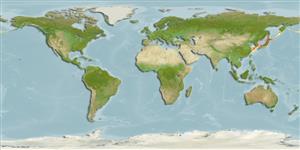Common names from other countries
Environment: milieu / climate zone / depth range / distribution range
Écologie
; profondeur 0 - 80 m (Ref. 289). Subtropical
Northwest Pacific: Korea, Japan, and China.
Length at first maturity / Taille / Poids / Âge
Maturity: Lm ? range ? - ? cm Max length : 2.5 cm TL mâle / non sexé; (Ref. 283)
Description synthétique
Morphologie
Body elongate, oval shaped; moderately elevated. Valve slate-blue, dark olive-grey or dark grayish brown with blotches of creamy white. Central areas minutely pitted in a chevron-like or quincuncial pattern. Lateral areas slightly raised, clearly marked; sculptured with flat, radiating costae. Girdle narrow; colored like the valves, sometimes with alternating bands of lighter and darker tones; covered with imbricating scales.
Occurs in stony bottoms and in oyster beds (Ref. 289); undersurfaces of stones and rocks (Ref. 1867). Found from intertidal to 80 m (Ref. 75835).
Life cycle and mating behavior
Maturité | Reproduction | Frai | Œufs | Fécondité | Larves
Members of the class Polyplacophora are mostly gonochoric. Life cycle: Eggs hatch into lecitotrophic planktonic trocophore larvae (no veliger stage) which later metamorphose and settle on the bottom as young adults.
Burghardt, G. and L. Burghardt. 2006. (Ref. 283)
Statut dans la liste rouge de l'IUCN (Ref. 130435)
statut CITES (Ref. 108899)
Not Evaluated
Not Evaluated
Menace pour l'homme
Harmless
Utilisations par l'homme
| FishSource |
Outils
Plus d'informations
Taille/ÂgeCroissanceLongueur-poidsLongueur-longueurMorphologieLarvesAbondance
Sources Internet
Estimates based on models
Preferred temperature
(Ref.
115969): 10.2 - 23.9, mean 17.1 (based on 60 cells).
Vulnérabilité
Low vulnerability (10 of 100).
Catégorie de prix
Unknown.
